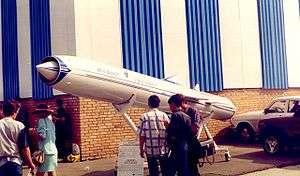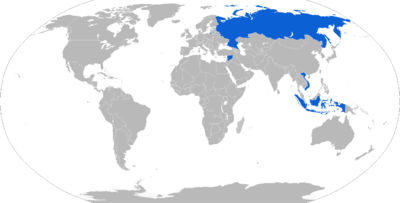P-800 Oniks
The P-800 Oniks (Russian: П-800 Оникс; English: Onyx), also known in export markets as Yakhont (Russian: Яхонт; English: ruby), is a Soviet / Russian supersonic anti-ship cruise missile developed by NPO Mashinostroyeniya as a ramjet version of P-80 Zubr. Its GRAU designation is 3M55, the air launched Kh-61 variant also exists. The missile has the NATO reporting codename SS-N-26 "Strobile". Development officially started in 1983, and in the 1990s the anti-ship missile was tested on the Project 1234.7 ship. In 2002 the missile passed the whole range of trials and was commissioned.[4] It is reportedly a replacement of the P-270 Moskit, but possibly also of the P-700 Granit. The P-800 was used as the basis for the joint Russian-Indian supersonic missile BrahMos.[5]
| Yakhont/Oniks missile | |
|---|---|
 Yakhont/Onyx missile at MAKS Airshow in Zhukovskiy, 1997. | |
| Type | Cruise missile Air-launched cruise missile Submarine-launched cruise missile Anti-ship missile Surface-to-surface missile Land-attack missile |
| Place of origin | Soviet Union / Russia |
| Service history | |
| In service | 2002–present[1] |
| Used by | See Operators |
| Wars | Syrian Civil War |
| Production history | |
| Manufacturer | NPO Mashinostroyeniya |
| Produced | 1987–present |
| Specifications | |
| Mass | 3,000 kg (6,614 lb) |
| Length | 8.9 m (29.2 ft) |
| Diameter | 0.7 m (2.3 ft) |
| Warhead | national ver. 300 kg semi-armour piercing HE, thermonuclear; for export 200 kg semi-armour piercing HE[2] |
Detonation mechanism | delay fuze |
| Engine | Ramjet 4 tons of thrust |
| Wingspan | 1.7 m (5.6 ft) |
| Propellant | kerosene liquid fuel |
Operational range | 600 km (370 mi; 320 nmi) (Oniks version for Russia) 800 km (500 mi; 430 nmi) (Oniks-M version for Russia) 120 to 300 km (75 to 186 mi; 65 to 162 nmi) depending on altitude (Yakhont export version) |
| Flight ceiling | 14,000 m |
| Flight altitude | 10 meters or higher |
| Maximum speed | Mach 2 |
Guidance system | midcourse inertial guidance, active radar homing-passive radar seeker head |
| Accuracy | 1.5 m[3] |
Launch platform | coastal installations, naval ships, Fixed-wing aircraft |
Description
The missile is carried in flight by aerodynamic lift. The solid-propellant booster is located in the ramjet's combustion chamber and is ejected by the airflow after it has burned out.
Advantages
- Over-the-horizon firing range
- Full autonomy of combat use ("fire and forget")
- A set of flexible ("low-profile sea-skimming", "high-low") trajectories
- High supersonic speed in all phases of flight
- Full harmonization for a wide range of platforms (surface ships, submarines and land-based launchers)
- Possible use of the missile in electronic countermeasures environment and under enemy fire
Operational history
Syria
In 2010 Sergei Prikhodko, senior adviser to the Russian President, has said that Russia intends to deliver P-800 to Syria based on the contracts signed in 2007.[6][7] Syria received 2 Bastion missile systems with 36 missiles each (72 in total).[8] The missiles' test was broadcast by Syrian state TV.[9]
In May 2013, Russia continued the contract delivery to the Syrian government supplying missiles with an advanced radar to make them more effective to counter any future foreign military invasion.[10][11] The warehouse containing the Bastion Missile was destroyed in an Israeli air strike on Latakia on 5 July 2013, but US intelligence analysts believe that some missiles had been removed before the attack.[12]
Oniks missiles were reportedly used in 2016 against ISIL targets.[13][14][15]
Specifications
- Length: 8.9 m
- Diameter: 0.7 m
- Wingspan: 1.7 m
- Weight: 3,100 kg
- Speed at altitude: 750 m/s (Mach 2.6)
- Surface speed: Mach 2
- Engine: ramjet, weight 200 kg, 4 tons of thrust
- Range: 120–300 km / 600 km for Russian ship/sub deployed non-export model[16]
- for the combined trajectory (hi-lo) – 300 km
- for low-altitude trajectory (lo-lo) – 120 km
- Flight altitude of 10,000–14,000 m
- Warhead: national version: 300 kg semi-armour piercing HE, thermonuclear; export version: 200 kg HE
- Fuel: kerosene T-6
Radar homing head
- all-weather monopulse active-passive, with frequency hopping
- Immunity: high, from active spoofing, dipole clouds
- Range: 50 km active[17]
- Launchable sea state – up to 7 points
- Warm-up time from power on: no more than 2 min
- Current consumption at 27 V circuit: up to 38 A
- Maximum angle of the target search: ± 45 °
- Homing weight: 85 kg
Variants
- 3M55 Oniks – Base version for Russia.
- P-800 Yakhont – Export version of Oniks.
- P-800 Bolid - Submarine-launched version of Yakhont.[18]
- Brahmos – Co-developed by Russia and India, based on Oniks, produced by BrahMos Aerospace Private Limited in India. BrahMos-II, a hypersonic version is also being developed.
- Bastion-P – Coast mobile missile system. Officially it entered service in 2015.[19]
- Kh-61 - Air launched air to surface version.
- Oniks-M - version of Oniks with improved range (up to 800 km), accuracy and ECCM capabilities.[20]
Platforms
Naval
- Current
- Admiral Grigorovich-class frigate
- Buyan-M-class corvette
- Karakurt-class corvette
- Steregushchiy-class corvette (export version)
- Yasen-class submarine
- Ahmad Yani-class frigate
- Admiral Gorshkov-class frigate
- Future
Land
Standard batteries of the K-300 Bastion-P (Бастион-П-Подвижный):
- 4 self-propelled launchers K-340P with 2 "Yakhont" missiles (crew of 3 persons)
- 1–2 Command and Control vehicles (ASBU) PBRK (crew of 5 persons)
- 1 security alert car (MOBD)
- 4 Transportation and loading vehicles (TLV K342P)
Operators





See also
References
- "MIC "NPO mashinostroyenia" - History". Archived from the original on 5 June 2014. Retrieved 23 December 2014.
- https://www.navyrecognition.com/index.php/news/defence-news/2019/september/7530-russia-mod-launches-supersonic-anti-ship-oniks-p-800-cruise-missile.html
- "P-800 Oniks (SS-N-26 Strobile) – Missile Defense Advocacy Alliance". Archived from the original on 21 March 2018. Retrieved 20 March 2018.
- "Nakat". Archived from the original on 3 November 2013. Retrieved 23 December 2014.
- "Brahmos Missiles - The Hans India". www.thehansindia.com. Archived from the original on 23 November 2015. Retrieved 22 November 2015.
- "BBC News - Syria crisis: Russia 'sends sophisticated weapons'". BBC News. Archived from the original on 31 May 2014. Retrieved 23 December 2014.
- "Despite Israeli protests, Russia won't halt arms sale to Syria". Haaretz.com. 30 August 2010. Archived from the original on 24 September 2015. Retrieved 23 December 2014.
- "Bastion missile systems to protect Russian naval base in Syria". Archived from the original on 11 November 2014. Retrieved 23 December 2014.
- "Syria Navy with Yakhont missile.flv". YouTube. Archived from the original on 3 September 2014. Retrieved 23 December 2014.
- "BBC News - Syria crisis: US rues Russian missiles sent to Damascus". BBC News. Archived from the original on 25 November 2014. Retrieved 23 December 2014.
- Gordon, Michael R.; Schmitt, Eric (16 May 2013). "Russia Sends More Advanced Missiles to Aid Assad in Syria". Archived from the original on 7 March 2017. Retrieved 28 February 2017 – via NYTimes.com.
- Gordon, Michael R. (31 July 2013). "Some Syria Missiles Eluded Israeli Strike, Officials Say". New York Times. Archived from the original on 25 June 2017. Retrieved 28 February 2017.
- "YouTube". www.youtube.com. Archived from the original on 18 August 2017. Retrieved 18 April 2017.
- "Russia uses aircraft carrier for big attack on Syrian rebels". 15 November 2016. Archived from the original on 18 May 2017. Retrieved 2 July 2017 – via www.reuters.com.
- Eskaf, Mahmoud (15 November 2016). "Russian bombing by aircraft carrier in Syria, hours after Putin-Trump call".
- Litovkin, Dmitry (8 August 2013). "Russian supersonic missiles behave like wolves".
- "P-800 Yakhont 3M-55 P-800 Bolid SS-N-26". www.globalsecurity.org. Archived from the original on 17 June 2019. Retrieved 17 June 2019.
- "ВПК "НПО машиностроения" - Новости". Archived from the original on 4 March 2016. Retrieved 16 October 2015.
- "Russia develops seaborne cruise missile with increased range capability — sources". Tass. 25 September 2019. Retrieved 25 September 2019.
- "Missiles and Rockets of Hezbollah". Missile Threat. Archived from the original on 26 April 2020.
- Amos Harel and Gili Cohen: Hezbollah: From terror group to army, Haaretz, 12 July 2016. Quote: "Hezbollah now [as compared to 2006] has Yakhont missiles with a longer range, better precision and diverse launching options." Archived 17 September 2017 at the Wayback Machine. Retrieved 13 July 2016.
- Koh Swee Lean Collin (31 May 2011). "Indonesia's Anti-ship Missiles: New Development In Naval Capabilities – Analysis". Eurasia Review. Archived from the original on 11 March 2014. Retrieved 11 March 2014.
- "Ракетный комплекс "Бастион" будет защищать берега Анапы". Archived from the original on 3 November 2014. Retrieved 23 December 2014.
- Wertheim, Eric (2007). The Naval Institute Guide to Combat Fleets of the World: Their Ships, Aircraft, and Systems. Naval Institute Press. p. 625. ISBN 9781591149552. Archived from the original on 23 October 2016. Retrieved 22 October 2016.
- "Russia parades Bastion-P in Crimea". Archived from the original on 3 November 2014. Retrieved 23 December 2014.
- "ЦАМТО / Новости / В Национальном центре управления обороной страны под руководством С.Шойгу прошел Единый день приемки военной продукции". Archived from the original on 4 March 2016. Retrieved 13 October 2015.
- Sputnik. "Russia's Northern Fleet Receives New Bastion Coastal Defense Systems". Archived from the original on 24 February 2016. Retrieved 25 February 2016.
- "Russian Navy received more than 100 Kalibr, Onix missiles in 3rd quarter". Archived from the original on 25 October 2016. Retrieved 26 October 2016.
- "Sputnik Images media library". Archived from the original on 7 November 2016. Retrieved 6 November 2016.
- Sputnik. "Message for Tokyo? Russia Deploys Bastion-P Coastal Defense System in Kamchatka". Archived from the original on 28 February 2017. Retrieved 28 February 2017.
- "Russia's First Yasen-Class Submarine is Combat-Ready". Archived from the original on 19 April 2016. Retrieved 13 May 2016.
- "Advanced anti-ship cruise missile systems enter service with Russian Navy". Archived from the original on 19 March 2017. Retrieved 18 March 2017.
- "National Centre for State Defence Control hosts Military Acceptance Day chaired by Russian Minister of Defence : Ministry of Defence of the Russian Federation". Eng.mil.ru. 31 January 2018. Archived from the original on 3 February 2018. Retrieved 17 June 2019.
- "Russian Navy takes delivery of 49 cruise missiles". TASS. Archived from the original on 17 June 2019. Retrieved 17 June 2019.
- "В Москве под руководством Верховного Главнокомандующего Вооруженными Силами России Владимира Путина прошло расширенное заседание Коллегии Минобороны : Министерство обороны Российской Федерации". Function.mil.ru. 18 December 2018. Archived from the original on 26 January 2019. Retrieved 17 June 2019.
- "Russia's Pacific Fleet receives new divisional set of Bastion mobile coastal defence missile system - Jane's 360". www.janes.com.
- "ЦАМТО / Новости / Тихоокеанский флот получил новый дивизионный комплект подвижного берегового ракетного комплекса «Бастион»". www.armstrade.org.
- https://tass.com/defense/1083915
- https://tass.com/defense/1114951
- "Lenta.ru: Наука и техника: Россия поставила Сирии противокорабельные комплексы "Бастион"". Archived from the original on 3 November 2014. Retrieved 23 December 2014.
- Haaretz (1 December 2011). "Report: Russia delivers supersonic cruise missiles to Syria". Haaretz. Archived from the original on 2 December 2011. Retrieved 1 December 2011.
- "/ / «»". 24 October 2011. Archived from the original on 3 November 2014. Retrieved 23 December 2014.
- "Indonesia's Anti-ship Missiles: New Development In Naval Capabilities - Analysis". Eurasia Review. Archived from the original on 6 June 2011. Retrieved 23 December 2014.
External links
- SS-N-26 (Federation of American Scientists)
- Sunburns, Yakhonts, Alfas and the Region (Australian Aviation, Sept 2000) (PDF)
- www.dtig.org Russian/Sovjet Sea-based Anti-Ship Missiles (pdf)
- Russia would supply Syria with P-800 Yakhont cruise missiles